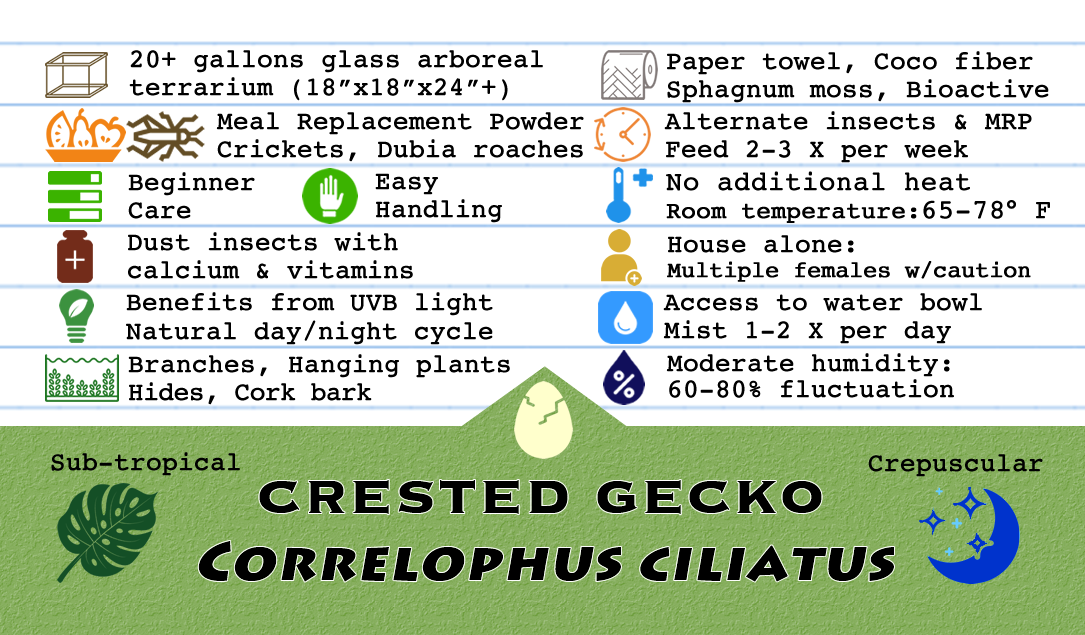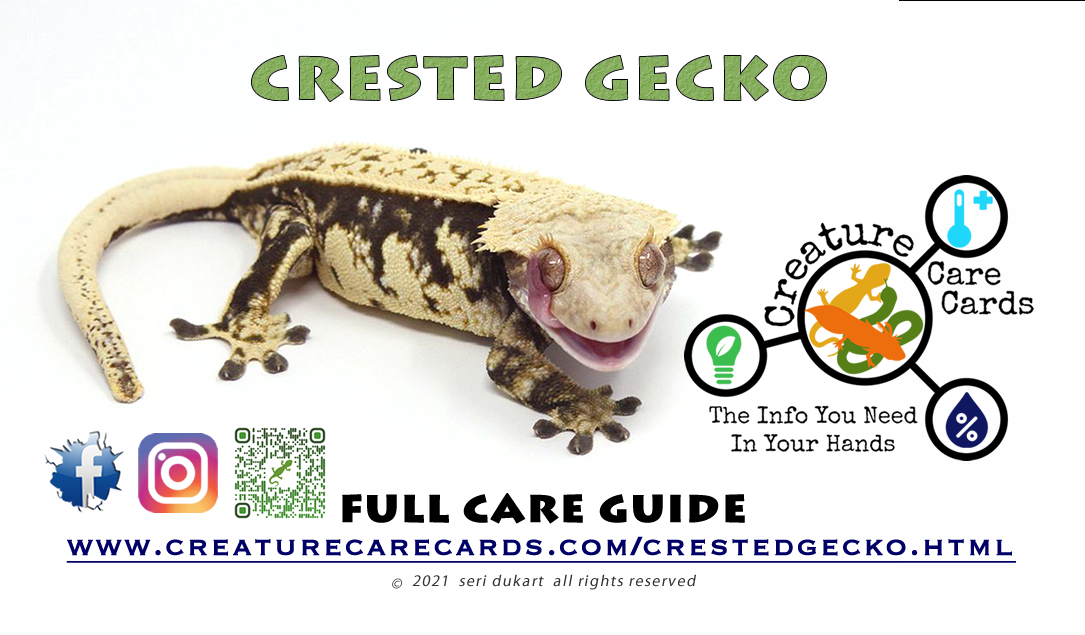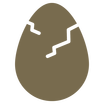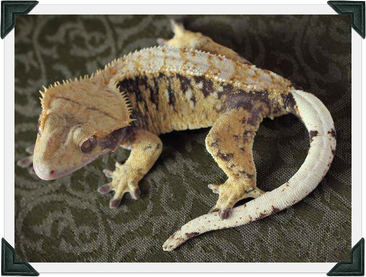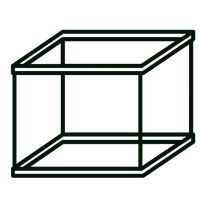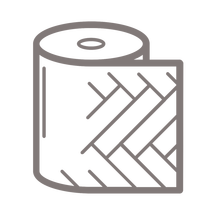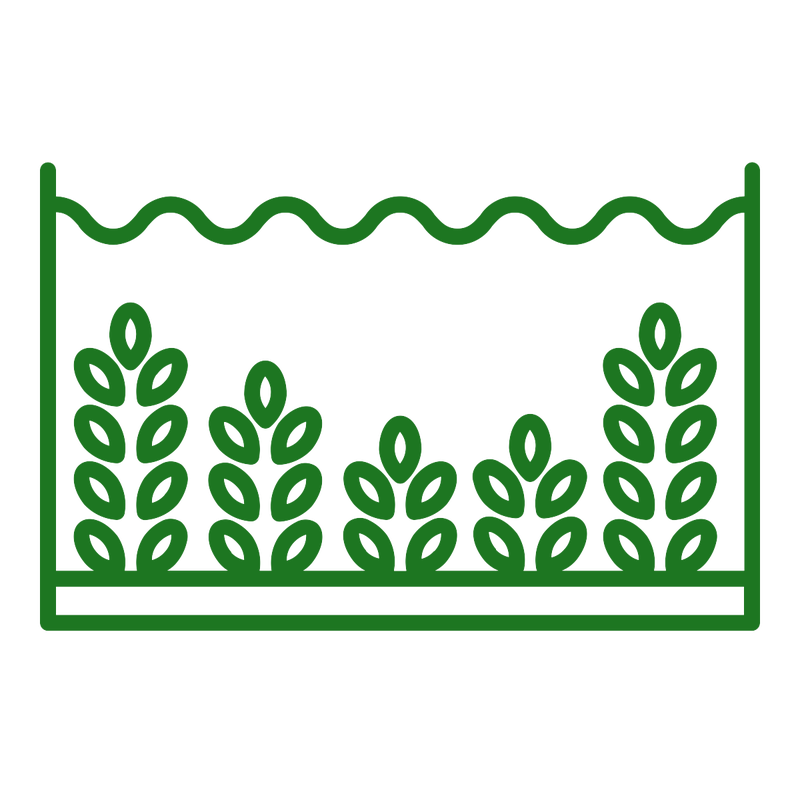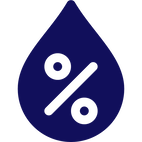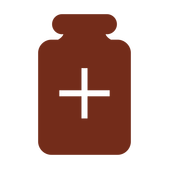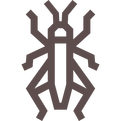Correlophus ciliatus - Crested Gecko
Crested geckos are a small, easy to keep gecko that come in a large variety of morphs. They are a medium sub-tropical, arboreal gecko and are crepuscular. They have the ability to change the intensity of their pigmentation (firing up or down) according to temperature, light, mood, etc.
|
Bringing Your New Pet Home
When you bring your new gecko home, you should already have a quarantine tank set up and ready to go. Place fresh water in a bowl in the tank, mist the tank and offer food, but be aware it is completely normal for them to refuse food for the first couple days, or even longer. You should keep this new gecko separate from any other geckos you may have for 90 days, to ensure there is nothing it could spread to your other animals. Monitor its eating and fecals as they may be strange for up to a couple weeks, but this is due to a new diet, supplements, and environment. It is recommended you do not handle your new gecko for the first 24-48 hours and keeping it to a minimum until it has started eating on its own. Always keep in mind, your new animal is in a new tank, with new decor/dishes/hides, and new faces watching them. They need time to become acclimated to it all. After this quarantine process, they can be safely introduced to their permanent enclosure if it is not already. Be sure to wash your hands before handling any other geckos during this time. |
|
Enclosure Depending on your need, there are a couple different ways to house a crested gecko. For the single gecko owner, a glass front opening terrarium with a screen top or door would be the most appealing. The general rule of thumb, is to have 20 gallons of tank for a single adult gecko, which is equal to a 18"x18"x24" or larger terrarium. Babies and juvies can be housed in smaller enclosures to ensure they are eating, but plan to upgrade as they grow. Some keepers modify plastic tubs with screen to keep their geckos as well. We highly recommend Zen Habitats 2'x2'x2' PVC Enclosure! 
Research bio-active and naturalistic, planted terrariums for more advanced options!
|
|
Substrate
Crested geckos thrive best on simple substrates such as paper towel, sphagnum moss, or eco-earth. Loose substrates should be used with caution; geckos can ingest it while hunting bugs and become impacted. If you use loose substrates, it is often recommended to feed out of enclosure or by tongs. Female crested geckos will lay eggs when they reach breeding age, even if they were never with a male. It is best to provide all female geckos with a lay box with loose substrate for them to lay their eggs and prevent egg binding. |
|
Compatibility
Geckos by nature are solitary animals. In crested geckos, females can be housed together with caution. They must be of the same size to prevent bullying. If you do choose to house more than one gecko together, more space is needed, with an additional 10 gallons of space per additional gecko. Adding more hides and decor will help prevent fighting. Males will fight with one another, and geckos of different sizes will bully and attack one another. Do not house males and females together unless you have researched breeding and are prepared for eggs and babies. Monitor females to be sure they are not picking on one another or one is not hoarding the food from the other. Remember, breeding is best left to the experts. If you do have fertile eggs, please research as babies require different care than adults, and eggs need to be kept on hatching medium and at particular temperatures to hatch. |
|
Temperatures
Crested geckos come from New Caledonia, where temperatures rarely reach over 80 degrees F. No heat source is needed for these geckos, unless your house regularly is under 66 degrees. They thrive best at room temperature of 72-78 degrees. Heat lamps can quickly cause dehydration and overheating. |
|
Lighting
Crested geckos are crepuscular, meaning they are active at twilight and night. They should be exposed to 10-12 hours of light per day. Reptiles benefit from the addition of tropical UVB lighting to their environment and we highly recommend it. Be sure all lights are on a timer and offer a natural day and night light cycle. |
|
Cage Decor
Since they are nocturnal and arboreal, they need to have places to hide from the daylight to sleep and climb. You will most often find crested geckos hanging out in branches or foliage, so decorate the tank heavily with hanging plants and other greenery, branches, cork bark, and a hide. Coconut hides are popular with crested geckos. |
|
Humidity and Shedding
Crested geckos are a sub-tropical species, so they require a moderate humidity level of around 60-80% with dry periods. You can best achieve this by misting the enclosure twice a day, once in the morning and once at night. While it is good to offer a shallow bowl of fresh water, most geckos will not drink from bowls and instead prefer to lick water droplets off the enclosure walls and plants. Misting will not only keep the humidity levels up, but offer them hydration as well.You do not want the cage soaking wet, and should allow it to dry out some between mistings. Crested geckos will shed their skin as they grow and regularly as adults. You’ll notice their color will appear dull when they are about to shed and they will have trouble sticking to the glass. Generally, the gecko will eat all of their shed, but you may see some of the shed skin in the cage. Some geckos will have unshed skin on their toes, we suggest letting your gecko soak in a shallow container of lukewarm water for a few minutes and you can assist the process by gently removing the skin using tweezers. Stuck shed is often an indication of humidity issues, so you can help this by misting more often or heavier.
|
|
Water
You can offer your crested gecko fresh water in a shallow bowl. Some will not drink directly from bowls and prefer to lick water from misting off leaves, but many have been seen drinking from bowls. Water can be treated with a commercial water treatment to remove any harsh chemicals from the water. Misting is important and should be done at least once daily to not only offer them droplets to lick, but to keep the humidity at a desirable level. |
|
Feeding
Crested geckos are insectivores and frugivores. Typically, their diet consists of crickets or dubia roaches and a commercial based, balanced fruit powder you prepare much like a smoothie. These diets are called meal replacement powders or MRPs. Do not feed mealworms or superworms, as they do not digest them well. Crickets can be placed in the enclosure during feeding time, but uneaten crickets should always be removed. MRPs can be mixed in small bowls and placed in enclosure. Insects should be gutloaded with a commercial gutload product. Gutloading refers to the practice of feeding the insects a nutritious diet before offering them to your gecko, to ensure the most balanced nutrition. Geckos that are under 4-6 months old should have MRPs available at all times and it should be changed out every other day with fresh food. Adults can go a few days between feedings and should be offered fresh food 2+ times per week. Keep on eye on food to be sure it is not molding, and remove or replace if it is. Crickets or roaches can be offered weekly or bi-weekly. Be sure the insect is appropriately sized for your gecko. It should be no larger than the space between their eyes. Uneaten insects should be removed after a few hours.Some crested geckos refuse insects - it is not uncommon that they will refuse live insects, especially as they get older. 
There are many MRPs on the market in a variety of flavors. Some of the most commonly found are Pangea Complete Gecko Diet and Repashy Gecko Diet. |
|
Handling
Crested geckos are usually open to being handled and with regular contact, can become very tame. Sit on the floor and let your gecko walk from hand to hand at their own pace. When handling your gecko, never hold or grab them by their tail. They have a natural ability to drop their tail as a defense mechanism. Crested geckos are very good jumpers and can be very fast until they are tamer and more comfortable with handling.
|
|
Shopping List with links to tried and true products
*optional |
